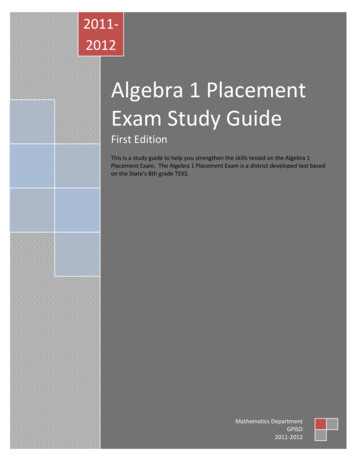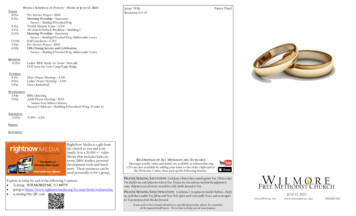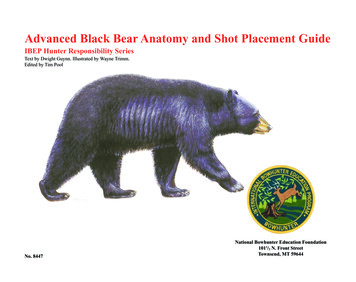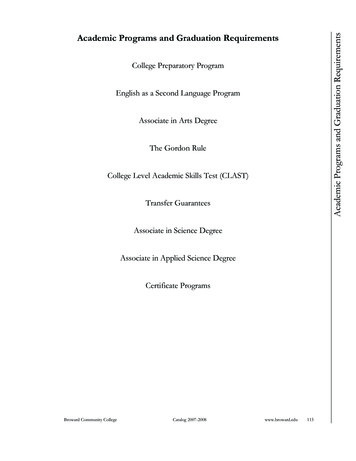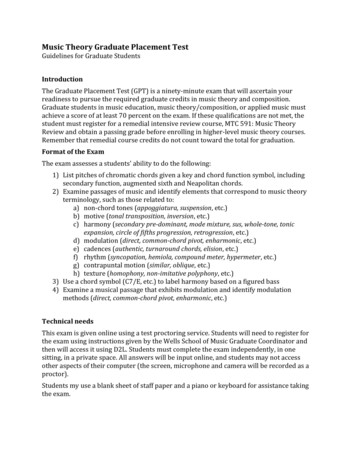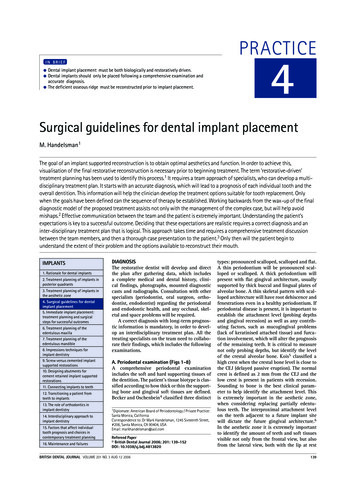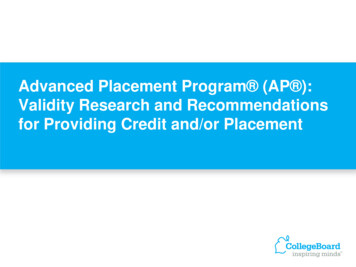
Transcription
STATESTATUTESCurrent ThroughJanuary 2018WHAT’S INSIDEPlacement of Children WithRelativesWhen a child is removed from the home and placedin out-of-home care, relatives are the preferredresource because this placement type maintains thechild’s connections with his or her family. In fact, inorder for states to receive federal payments for fostercare and adoption assistance, federal law under titleIV-E of the Social Security Act requires that they“consider giving preference to an adult relative over anonrelated caregiver when determining a placementfor a child, provided that the relative caregiver meetsall relevant state child protection standards.”1 TitleIV-E further requires all states2 operating a titleIV-E program to exercise due diligence to identifyand provide notice to all grandparents, all parentsof a sibling of the child, where such parent has legalcustody of the sibling, and other adult relatives of thechild (including any other adult relatives suggestedby the parents) that (1) the child has been or is beingremoved from the custody of his or her parents, (2)the options the relative has to participate in the careand placement of the child, and (3) the requirementsto become a foster parent to the child.342 U.S.C. § 671(a)(19) (LexisNexis 2017). Placement refers to the placing of a child in thehome of an individual other than a parent or guardian or in a facility other than a youthservices center.2The term “state” as used in this document includes the District of Columbia, Puerto Rico,the U.S. Virgin Islands, Guam, and American Samoa (42 U.S. C. § 410(h) (LexisNexis 2017)).All, with the exception of Guam and American Samoa are approved to operate the title IV-EFoster Care and Adoption Assistance Program and are subject to the requirements of titleIV-E of the Social Security Act. This document does not include references to any tribal code.342 U.S.C. § 671(a)(29) (LexisNexis 2017), as amended by the FosteringConnections to Success and Increasing Adoptions Act of 2008.1Children’s Bureau/ACYF/ACF/HHS800.394.3366 Email: info@childwelfare.gov https://www.childwelfare.govGiving preference torelatives for out-of-homeplacementsApproving relativeplacementsPlacement of siblingsAdoption by relativesSummaries of state lawsTo find statuteinformation for aparticular state,go aws-policies/state/.
https://www.childwelfare.govPlacement of Children With RelativesTitle IV-E of the Social Security Act provides to statesfederal reimbursement for a part of the cost of providingfoster care, adoption assistance, and kinship guardianshipassistance on behalf of each child who meets federaleligibility criteria (as described in 42 U.S.C. §§ 672 and 673).4These reimbursements are available to public agenciessuitable placement resource for the child.8 Other relativesthat may be considered for placement of the child includegreat-grandparents, aunts, uncles, adult siblings, cousins,or the parent of the child’s sibling. For Indian children,11 states have statutes specifically allowing members ofan Indian child’s tribe to be considered “extended familymembers” for placement purposes.9in all 50 states, the District of Columbia, and Puerto Ricoas well as to any Indian tribe, tribal organization, or tribalconsortium operating an approved program to providefoster care maintenance payments, adoption assistance,and, at the agency’s option, a guardianship assistanceprogram.5Giving Preference to Relatives for Outof-Home PlacementsFor this publication, statutes have been collected acrossall states, the District of Columbia, American Samoa,Guam, the Northern Mariana Islands, Puerto Rico, and theU.S. Virgin Islands that describe the specific requirementsfor giving preference to a suitable relative when achild is in need of out-of-home care, and an analysis ofthe information collected informs the discussion thatfollows.6 This analysis indicates that each state defines“relative” somewhat differently, including relatives byblood, marriage, or adoption ranging from the first to thefifth degree. While all title IV-E programs must considergiving preference to relative placements, approximately48 states, the District of Columbia, Guam, and PuertoRico include this language in their statutes.7 Of theagencies that address these requirements via statutes orregulations, preference for placement is given to the child’sgrandparents, although 12 states require that agenciesmust first determine whether a noncustodial parent is aSee Child Welfare: An Overview of Federal Programs and Their CurrentFunding (2017), from the Congressional Research Service at https://fas.org/sgp/crs/misc/R43458.pdf (1,200 KB).5See Title IV-E Foster Care (2012), from the Children’s Bureau at er-care.6This analysis is limited to statutes and regulation. States also can implementthe title IV-E requirements through policy or procedure.7The word “approximately” is used to stress the fact that States frequentlyamend their laws. This information is current only through January 2018. Thestatutes in New Hampshire, West Virginia, American Samoa, and the VirginIslands do not express a preference for relative placements in their statutes.4In 28 states, the District of Columbia, and Guam, whena suitable relative cannot be found, the agency mayconsider placing the child with “fictive kin.”10 The term“fictive kin” refers to a person who is not related to thechild by blood, marriage, or adoption but who is knownto the family, has a substantial and positive relationshipwith the child, and is willing and able to provide a suitablehome for the child. Examples of fictive kin caregiverscan include the adoptive parent of the child’s sibling, anonrelated godparent, a close family friend, a neighbor, aclergy member, or other adult who has a close and caringrelationship with the child.While all title IV-E programs must exercise due diligenceto identify and provide notice to relatives, 26 states andGuam utilize statutes and regulations to require socialservices agencies to exercise due diligence in identifyingand locating a child’s relative when out-of-homeplacement is needed.11 The steps that need to be takeninclude: Requiring the child’s parent to provide a list of thenames, addresses, and telephone numbers of everygrandparent and other adult relatives of the childArizona, Arkansas, Colorado, Florida, Montana, New York, North Carolina,Ohio, Pennsylvania, Utah, Vermont, and Wyoming.9Alaska, Minnesota, Missouri, Nebraska, New Mexico, North Carolina,Oklahoma, Oregon, Pennsylvania, Utah, and Washington. Under the federalIndian Child Welfare Act (ICWA), the term “extended family member” isdefined by the law or custom of the Indian child’s tribe or, in the absence ofsuch law or custom, is a person who is at least age 18 and who is the Indianchild’s grandparent, aunt or uncle, brother or sister, brother-in-law or sisterin-law, niece or nephew, first or second cousin, or stepparent. (See 25 U.S.C.§ 1903(2) (LexisNexis 2017)). ICWA also addresses placement preferences forchildren meting the definition of an Indian child.10Alaska, Arkansas, Connecticut, Florida, Georgia, Hawaii, Idaho, Illinois,Indiana, Kansas, Kentucky, Louisiana, Massachusetts, Minnesota, Missouri,Nevada, New Jersey, New York, North Carolina, North Dakota, Ohio, Oregon,Pennsylvania, Rhode Island, South Carolina, Texas, Utah, and Vermont.11Arkansas, California, Colorado, Connecticut, Delaware, Florida, Georgia,Hawaii, Idaho, Illinois, Indiana, Iowa, Massachusetts, Michigan, Minnesota,Missouri, Nevada, New Jersey, New Mexico, New York, North Carolina,Oklahoma, Pennsylvania, Rhode Island, South Carolina, and Vermont.8This material may be freely reproduced and distributed. However, when doing so, please credit Child Welfare Information Gateway.This publication is available online at s-policies/statutes/placement/.2
https://www.childwelfare.govPlacement of Children With Relatives Exercising due diligence to identify all grandparentsand other adult relatives of the child, including anyadult relatives suggested by the parents, subject toexceptions due to family or domestic violence Contacting the relatives within 30 days to inform themof the child’s removal from home and to explain theoptions that the relative has to participate in the careand placement of the child Informing the relative of any options that may be lostby not responding to the notice Assessing the relative’s willingness and suitability toprovide care for the childApproving Relative PlacementsWhen the state social services department is grantedcustody of a child, the department assumes responsibilityfor making a safe and appropriate placement for thechild. Statutes and regulations in 20 states and the Districtof Columbia require that the relative providing out-ofhome care must be licensed or certified as a foster familyhome,12 although eight of these states allow temporary orprovisional approval while the relative works to completethe requirements for full approval or licensure.13 In sevenstates, licensure is not required by statute or regulation,but relative care providers may elect to be certified.14 Infour states, statutes and regulations do not require kincare providers to be licensed.15In all of the 20 states and the District of Columbia thatuse statutes and regulations to address requirementsfor relative placements, before a child can be placed inthe home of a relative, the child-placing agency must doan assessment to determine that the relative is “fit andwilling” to provide a suitable placement for the child,able to ensure the child’s safety, and able to meet thechild’s needs. While all title IV-E programs must requireall prospective foster and adoptive parents to undergoAlabama, Alaska, Arkansas, Connecticut, Hawaii, Louisiana, Maryland,Massachusetts, Minnesota, Missouri, Montana, Nebraska, New Jersey, NewYork, North Dakota, Rhode Island, South Carolina, Tennessee, Virginia, andWisconsin.13Arkansas, Connecticut, Maryland, Massachusetts, Minnesota, Montana,North Dakota, and Rhode Island.14Arizona, Illinois, Indiana, Michigan, Nebraska, Virginia, and Washington.15Florida, Kansas, Kentucky, and New Mexico.12criminal background checks, laws in 31 states, the Districtof Columbia, Guam, the Northern Mariana Islands,and Puerto Rico require relatives to undergo a criminalbackground check that includes all adult members of thehousehold.16 Child abuse and neglect central registrychecks also are required.17Placement of SiblingsThe Fostering Connections to Success and IncreasingAdoptions Act of 2008 (P.L. 110-351) amended title IV-Eplan provisions to require that title IV-E agencies makereasonable efforts to place siblings removed from theirhome in the same foster care, adoption, or guardianshipplacement or, if that is not possible, facilitate visits orongoing contacts for siblings that cannot be placedtogether, unless it is contrary to the safety or well-being ofany of the siblings to do so.18Statutes or regulations in approximately 37 states, theDistrict of Columbia, and Guam require child-placingagencies to make reasonable efforts to place siblings inthe same home when they are in need of out-of-homecare except when there are documented reasons whya joint placement would not be in the best interests ofany of the siblings.19 Reasonable efforts include givingplacement preference to persons that are willing andable to provide appropriate care for all of the children inthe home. In addition, the agency may grant variancesto one or more licensing standards regulating fosterfamily homes, including exceptions to the number ofAlabama, Alaska, Arizona, Arkansas, California, Colorado, Connecticut,Florida, Georgia, Illinois, Indiana, Kentucky, Louisiana, Maine, Maryland,Massachusetts, Minnesota, Mississippi, Montana, New Jersey, North Dakota,Ohio, Rhode Island, South Carolina, Tennessee, Texas, Utah, Washington,Vermont, Wisconsin, and Wyoming.17Title IV-E requires these checks regardless of whether foster caremaintenance payments are to be made on behalf of the child; see 42 U.S.C.§ 671(a)(20) (LexisNexis 2017). For more information on the requirements forbackground checks for foster and adoptive parents, including criminal recordsand child abuse and neglect central registries, see Information Gateway’sBackground Checks for Prospective Foster, Adoptive, and Kinship Caregiversat s-policies/statutes/background/.1842 U.S.C. § 671(a)(31) (LexisNexis 2017).19Alaska, Arizona, Arkansas, California, Colorado, Connecticut, Delaware,Georgia, Hawaii, Idaho, Illinois, Iowa, Kentucky, Maryland, Massachusetts,Michigan, Minnesota, Mississippi, Missouri, Nebraska, Nevada, NewHampshire, New Mexico, New York, North Carolina, North Dakota, Ohio,Oklahoma, Oregon, Pennsylvania, Rhode Island, Texas, Utah, Virginia,Washington, West Virginia, and Wisconsin.16This material may be freely reproduced and distributed. However, when doing so, please credit Child Welfare Information Gateway.This publication is available online at s-policies/statutes/placement/.3
https://www.childwelfare.govPlacement of Children With Relativeschildren that may be placed in the home, as long as thehome otherwise complies with fire and building safetyregulations. In 35 states and Puerto Rico, statutes orregulations require that siblings who cannot be placedtogether be given opportunities for visits and/or othercontact or communication.20Adoption by RelativesApproximately 11 states21 require in statute or regulationthat state agencies give preference to relatives whenmaking adoptive placements for children in theircustody.22 However, in three states, if the child has beenplaced in foster care with a nonrelative and has beenliving with the same foster parent for significant period oftime when he or she becomes available for adoption, thenonrelative foster parent may be given first preference toadopt.23This publication is a product of the State StatutesSeries prepared by Child Welfare InformationGateway. While every attempt has been madeto be complete, additional information on thesetopics may be in other sections of a state’s codeas well as agency regulations, case law, andinformal practices and procedures.Suggested Citation:Child Welfare Information Gateway. (2018). Placement ofchildren with relatives. Washington, DC: U.S. Departmentof Health and Human Services, Children’s Bureau.In the statutes or regulations of approximately 35 states,when a parent places the child directly with a relative, thelaws provide for a streamlined adoption process, such asnot requiring a preplacement assessment or home studyunless specifically ordered by the court.24 In 11 states, thechild must have resided with the relative for a period oftime or have established a significant relationship with therelative in some other way.25 All states require checks ofcriminal history records and child abuse central registriesfor the adopting relatives and other adult householdmembers.26Arizona, California, Connecticut, Florida, Georgia, Hawaii, Idaho, Illinois,Indiana, Iowa, Kentucky, Louisiana, Maine, Maryland, Massachusetts, Michigan,Minnesota, Mississippi, Missouri, Nebraska, New Hampshire, New Jersey,New Mexico, New York, North Dakota, Ohio, Oklahoma, Pennsylvania, RhodeIsland, South Carolina, Texas, Utah, Virginia, Washington, and Wisconsin.21Arkansas, California, Illinois, Minnesota, Nebraska, New York, Ohio,Oregon, Rhode Island, Washington, and Wisconsin.22Other states may require this is in agency policy or procedure.23Missouri, New York, and Tennessee.24Alabama, Alaska, Arizona, Arkansas, California, Colorado, Florida, Idaho,Illinois, Indiana, Iowa, Kansas, Kentucky, Louisiana, Maine, Maryland, Michigan,Mississippi, Montana, Nebraska, Nevada, New Hampshire, New Jersey, NewMexico, North Carolina, North Dakota, Oklahoma, Pennsylvania, Rhode Island,South Carolina, Tennessee, Texas, Utah, Vermont, and Virginia.25Alabama, Alaska, California, Colorado, Delaware, Florida, Louisiana, NewHampshire, New Mexico, North Dakota, and Virginia.26Title IV-E requires these checks regardless of whether adoption assistancepayments are to be made on behalf of the child; see 42 U.S.C. § 671(a)(20)(LexisNexis 2017). For more information on the requirements for backgroundchecks for foster and adoptive parents, see Information Gateway’s BackgroundChecks for Prospective Foster, Adoptive, and Kinship Caregivers at s-policies/statutes/background/.20This material may be freely reproduced and distributed. However, when doing so, please credit Child Welfare Information Gateway.This publication is available online at s-policies/statutes/placement/.4
Placement of Children With t Through January 2018Relative Placement for Foster Care and GuardianshipCitation: Ala. Code § 38-12-2; Admin. Code r. 660-5-28-.05When a child has been removed from his or her home and is in the care, custody, or guardianship of the Department of HumanResources, the department shall attempt to place the child with a relative for kinship foster care. If the relative is approved bythe department to provide foster care services, in accordance with rules and regulations adopted by the department regardingfoster care services, and a placement with the relative is made, the relative may receive payment for the full foster care rate only asprovided by federal law for the care of the child and any other benefits that might be available to foster parents, whether in money orin services.A relative shall be an individual who is legally related to the child by blood, marriage, or adoption within the fourth degree of kinship,including only a brother, sister, uncle, aunt, first cousin, grandparent, great-grandparent, great-great-grandparent, great-aunt, greatuncle, niece, nephew, grandniece, grandnephew, or a stepparent. For the purposes of kinship foster care, the blood relationship willcontinue to be recognized in defining a relative after termination of parental rights.In regulation: When substitute care becomes necessary, children should be placed in the least restrictive setting possible. Thismeans the most familylike setting that can provide the environment and services needed to serve the child's best interests andspecial needs. In substitute care, relative placement should always be given first consideration, after which foster family care, grouphome care, and institutional care are to be considered in that order.Requirements for Placement With RelativesCitation: Ala. Code §§ 38-12-2; 38-12-3; 38-12-4The kinship foster parent shall be age 21 or older unless the department provides otherwise by rule to carry out the provisions of thischapter.The department may waive standards for kinship foster care as provided by department rule and as permitted by other state andfederal law.A person may become a kinship foster parent only upon the completion of an investigation to ascertain if there is a state or federalrecord of criminal history for the prospective kinship foster parent or any other adult residing in the prospective foster parent's home.The department shall determine whether the person is able to care effectively for the foster child by the following methods: Reviewing personal and professional references Observing the kinship foster parent with household members during a home visit Interviewing the kinship foster parentRequirements for Placement of SiblingsCitation: Ala. Code § 12-15-315(e)If the permanency plan for a child is with a kinship guardian, the individualized service plan must contain the reasons for anyseparation of siblings during placement.Relatives Who May AdoptCitation: Ala. Code § 26-10A-28Relatives include
the U.S. Virgin Islands, Guam, and American Samoa (42 U.S. C. § 410(h) (LexisNexis 2017)). All, with the exception of Guam and American Samoa are approved to operate the title IV-E Foster Care and Adoption Assistance Program and are subject to t
